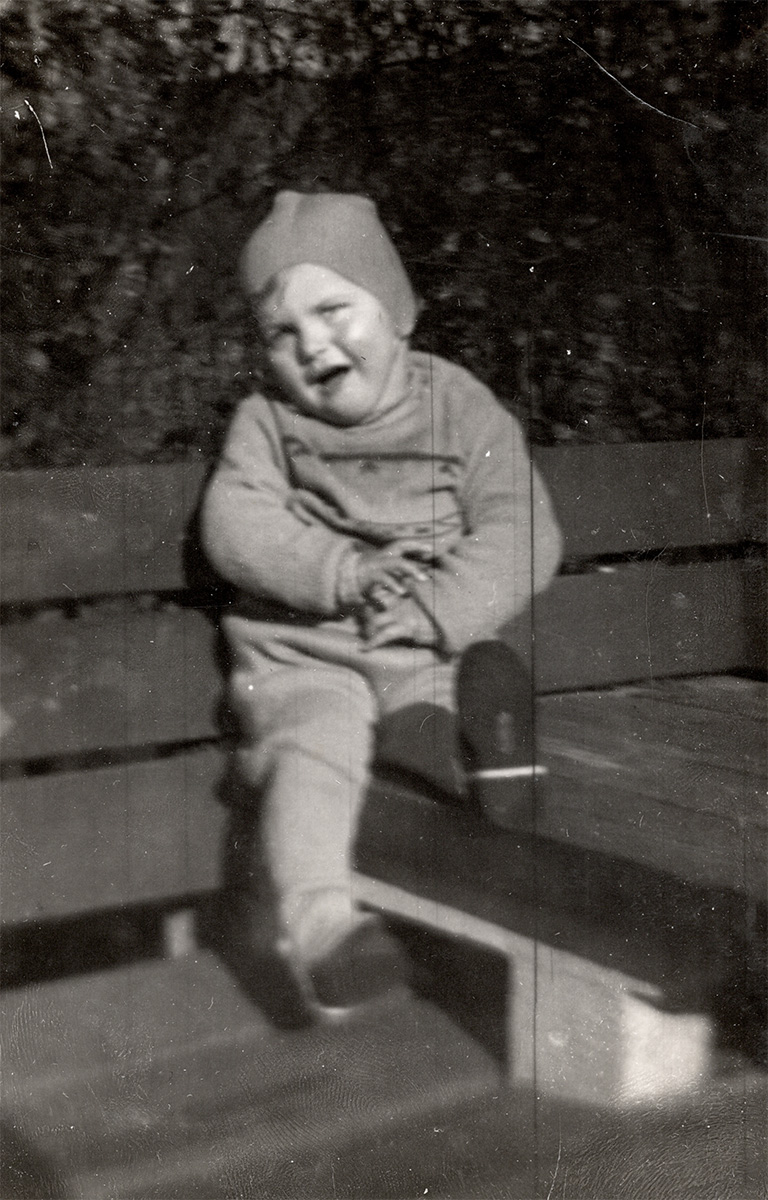NFC zu 03-39-09-02

Christian Meins, Hamburg-Hammerbrook, around 1941.
Private property of Heidi Frahm.
CHRISTIAN MEINS (1939 – 1943)
Christian Meins was the first child of Gretchen (Gretel) and Hermann Meins. Both came from Hamburg. Gretel came from a communist family, while Hermann was a social democrat and, as a teenager, took part in street battles against the Nazis. Gretel and Hermann met in a restaurant where Gretel was helping out in the kitchen. They married on 18 January 1939, when Gretel was already pregnant. After the wedding, the couple moved into their own rented flat in Hamburg-Hammerbrook, near Christian’s maternal grandparents. They had little contact with his paternal grandmother, who ran her own pub and was considered assertive.
Christian’s father Hermann was an electrician and worked in the arms industry, including at Peenemünde on the V2 rocket and at the Technical Relief Service. Thanks to his good income, Gretel did not need to work after Christian was born. Christian was born on 10 June 1939. He was named after his deceased paternal grandfather. At birth, he had the umbilical cord wrapped twice around his neck and had to be admitted to the Rotenburg Children’s Hospital. He never recovered from this birth injury.
Christian was developmentally delayed and suffered from epileptic seizures. The seizures stopped when he was around three years old. From then on, Christian was very lively and particularly enjoyed slamming doors, which he could do for hours on end. His parents must have loved Christian very much. His father worked overtime so that he could pay the alternative practitioner’s bills from his extra wages. They were very happy with their disabled child. He was the ‘prince,’ reports his sister Heidi Frahm. She herself remained in the shadow of her deceased brother during her childhood.
Christian, his parents and grandparents were bombed out during the Hamburg ‘fire storm’ in the summer of 1943. They were evacuated to Burgdorf in Lower Saxony. There, on 3 August 1943, Christian was presented to the health authorities and deemed by the medical officer to be ‘in need of institutional care,’ ‘especially since, given the difficult domestic circumstances (bomb damage), proper accommodation in his own household is no longer possible.’ Because his mother was to be sent on to Bayreuth shortly thereafter and his father had to return to Hamburg just as urgently in order to resume his work at Blohm & Voss, Christian’s admission to the sanatorium and nursing home was arranged by telephone due to the urgency of the situation.
Just two days later, on his way back to Hamburg, Hermann personally took his son to the children’s ward in Lüneburg. Once he arrived in Hamburg, he organised a so-called “Ley-Bude”. This makeshift accommodation meant that Gretel and her parents were able to return to Hamburg before the end of the war. Christian was murdered on 29 August 1943, just three weeks after his admission. The official cause of death was bronchitis.
Because Christian Meins had been admitted and registered as a ‘bomb-damaged child,’ he was not buried in the institution cemetery but in the central cemetery in Lüneburg. In 1952, his grave fell under the War Graves Act. It has therefore been preserved to this day as a single grave with a gravestone. Heidi was never able to forget the fate of her older brother. Born in 1947, her childhood was also marked by the memory of her dead brother. For over 15 years, she tried to clarify his fate. Assuming that there was no grave, she had a nameplate placed in his memory at the Ohlsdorf Cemetery in Hamburg. In September 2021, she visited her brother’s grave for the first time.
back

